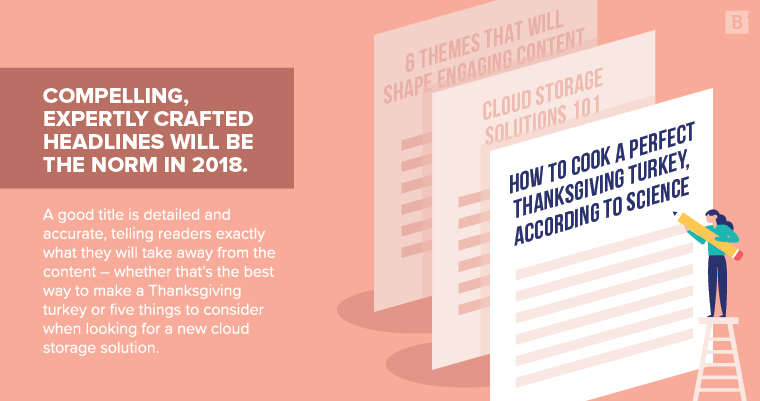The strategies we used in 2016 are completely different from the ones in 2017, and 2018’s will be just as unique. That said, the primary consistency in this industry is engagement. Your audience has a limited amount of attention to give, and everything else in the world is competing against you for it.
Engaging content is what ensures you come out on top. Every marketer’s goal is to get audiences more engaged with their businesses, whether that means more email opens, sales demos, white paper downloads or social shares.
So, if the industry is constantly shifting, what will engaging content look like in 2018? We here at Brafton have some ideas:

1. The concepts of quantity and quality will finally merge
In 2018, no one will argue quality versus quantity anymore. Instead, it’ll be all about combining both, giving audiences the best bang for their buck (well, the most usable content for their time).
Originally, content marketing rested upon lengthy posts stuffed with keywords. The information itself didn’t matter; all that counted was that the content hit the right triggers for search.
Then, Google got smarter, and the industry focused on creating relevant pieces. However, marketers also believed that people’s attention spans were getting shorter, resulting in condensed content often written in listicle format.
Now, thanks to advanced SEO tools, we can clearly see that:
- Longer pieces rank extremely well. Research from Hubspot suggests the ideal length for a blog post is a whopping 2,100 words. Buffer is a bit more conservative, recommending 1,600 words.
- The strongest groups of keywords are not only relevant but varied. Audiences want to read a lot of words about a lot of different things.
- Content depth is important. Take it from Jeff Baker – revising existing content to be more comprehensive provides significant results.
Admittedly, it’s taken the content marketing industry a long time to get here. After all, the idea seems obvious when you consider consumers’ viewpoints. Of course they want as many details as they can get in a single place, but they also want what they read to be informative. In the past, content marketing has flirted with length and relevance independently but rarely both at the same time.
That will change this year as search algorithms get better at predicting and adapting to user intent – particularly users interested in making a purchase. A casual reader may be interested in a brief “Top 10 Vacation Destinations” article, but someone planning to purchase travel insurance wants content that’s a lot more in depth – something like “Top 10 Ways To Prepare for the Vacation of Your Dreams.”

2. Compelling, expertly crafted headlines will be the norm
Which of the following headlines is more engaging to read?
- 6 Themes That Will Shape Engaging Content in 2018
- Making Engaging Content
The answer, of course, is the first. This headline is more informative, uses stronger words and conveys more emotion than the second. And I didn’t just make this up; I used one of my favorite tools, CoSchedule’s Headline Analyzer, to judge the strength of each option.
It’s a long-standing tenet of journalism that similarly applies to content marketing: Strong headlines correlate to higher readership. A good title is detailed and accurate, telling readers exactly what they will take away from the content – whether that’s the best way to make a Thanksgiving turkey or five things to consider when looking for a new cloud-storage solution.
3. User experience will integrate with content strategy
One of my personal content marketing pet peeves is when I head to a company’s home page and have to scroll all the way to the bottom to access their blog. Similarly, I refuse to spend time clicking through several links before finding (finally!) the page I want.
A lot of people agree, which is why website audits that address user experience will be paramount this year. After all, your content won’t engage readers if they have to work to find it, no matter how long or well-written it may be.
“But wait!” you might say. “Does my website’s layout really matter that much? After all, my goal is to be the very first hit on Google, so won’t most of my leads come from search?”
It’s true that optimizing your website for search is important and that, in this endeavor, words and code matter more than appearance and navigation. However, a search-only strategy ignores a critical subset of your audience: your die-hard readers. They don’t need Google.
They’ve got your website memorized (and hopefully bookmarked). But forgetting them in favor of chasing new readers is like that meme of the boyfriend with the wandering eye. You know the one.

See that indignant girl in the blue tank top? She’s your loyal reader, eager for your content and upset that she has to work so hard to find it.
This is the last thing you want, because losing devoted readers compromises your industry standing. After all, you want to be a thought leader, the first source people turn to when they want information on a specific topic. You can’t reach this goal without die-hard readers accessing and promoting your content.
To push this metaphor to its breaking point, don’t jeopardize your relationship with your meme girlfriend. Strengthen it by auditing your website so she can easily find what she needs. Then, she’ll sing praises about how she has the best boyfriend – erm, the best vendor or service provider – in the entire world.
4. AR and VR will capture audience attention
Everyone loves the word “free,” and that’s why trial offers are a great tool within the sales funnel. This idea will be pushed even further this year as more brands incorporate augmented and virtual reality into their trial content, giving their audiences an experience unlike any they’ve seen before.
AR and VR have two primary advantages over traditional trials:
- Novelty. People are more interested in brands that try something new, or at least something that hasn’t been used often. New technology like AR is a great way to boost engagement, especially as this type of tech starts delivering an increasingly high-quality experience.
- Accessibility. According to Pew Research Center, 77 percent of Americans own a smartphone. These mobile devices are a great way to bring VR and AR to average consumers – no fancy or expensive equipment necessary. By taking advantage of technology your audience already owns, you reduce barriers to an actual trial of your product (for example, replacing the process of holding a demo with an easily downloadable app) while also becoming more connected to your audience.
To see these ideas in action, take a look at this experience from Volvo:
Doesn’t that look so much more fun than driving to a dealership and working with a pushy salesperson? While it doesn’t give you the full experience of driving an XC90, Volvo Reality is fun, immersive and engaging – just what we want all content to be.
Furthermore, when adapting this idea for your own brand, you can alter user interface of your AR or VR program so certain actions or clickable areas take users directly to your content. In the example of a VR test-driving tool, playing around with the radio could direct users to a landing page about the car’s interior features. In this way, virtual reality becomes a way to increase engagement on multiple fronts, using app downloads to boost clicks to landing pages.
5. Ephemeral content will continue to expand
I’ve talked about ephemeral content before, and I stick by my assertion that it will grow more interesting and important this year.
Ephemeral content works by creating a sense of urgency. Viewers won’t want to miss out on whatever it is you have to say, so they’ll read or watch your videos within minutes rather than days. And with social media platforms constantly enhancing their ephemeral content options, you have the chance to engage your audience even further – perhaps even giving them a role in your decisions.
For instance, why not use an Instagram stories poll to ask viewers what topics they’re interested in? You can refer to these results when creating your next white paper, webinar or blog post.
By asking your audience relevant questions and collecting their thoughts, readers truly feel like their opinions – and, therefore, their level of satisfaction – matter to your company.
Furthermore, ephemeral content gives you a new way to show readers the core of your company. You don’t need to repeat the basics here. Be friendly and personable rather than stuffy and corporate, and you’ll see your followers, likes and comments skyrocket.
6. Inline media will grow more sophisticated
Inline images and pull quotes are nothing new, but you’ll need more to make your content engaging in 2018. At the very minimum, you should trade stock photos (which often aren’t relevant to the topic at hand) for quality images with a more realistic edge.
Also, consider custom illustrations. They give your content a fun, unique edge, guaranteeing it’ll be unlike any other. The same is true of infographics, which display data points in a format that’s much more interesting and shareable than white papers.
Still, the best inline media also serves as rich content – that is, content that facilitates an action from the user. Think of a caption in a blog article that readers can immediately add to their Twitter feeds by clicking a link, just like the sentence below:
In 2018, inline media will grow more creative and sophisticated. (Click to tweet.)
Click-to-tweet features are exceptionally awesome because they both encourage engagement and promote your brand’s messaging.
On the other hand, you can increase audience awareness of your social media presence by embedding pieces from Twitter and Instagram directly into your content. For example, embedding an Instagram post of your corporate office – instead of simply including a regular JPEG of the photo – allows readers to click to your Instagram profile and experience another aspect of your business. Similarly, a YouTube embed connects audiences to your channel much more strongly than a simple video.
As you can probably tell by the length of this article, creating engaging content isn’t something you can do on autopilot. It requires data, strategy and good old common sense, understanding what your readers want, how they want it and how to get them to read it.
That said, there’s a lot on the horizon, and we’re excited to see the creative ideas we and other marketers come up with.
What’s your plan for creating engaging content this year?





